Copperheads and Similar Looking Harmless Species
Click here to take the Copperhead Test
First, we'll take a look at Eastern Copperheads and point out their most identifying characteristics. Copperheads are born alive and with the exception of the tail tip, they are colored and patterned the same as adults. The following four photographs are of baby/juvenile Eastern Copperheads. Note the sulfur yellow colored tail tip. The yellow tail tip is used as a lure for frogs, lizards and other prey items. As the snake ages the bright tail tip fades. The only other Virginia snake with a bright yellowish to yellowish green tail tip is the venomous Northern Cottonmouth.
* Click on a thumbnail to see a larger version
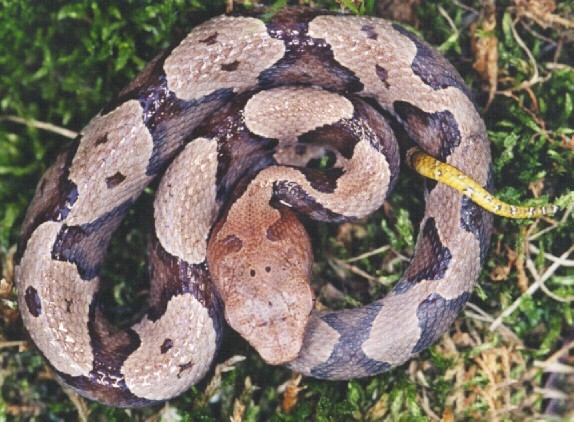
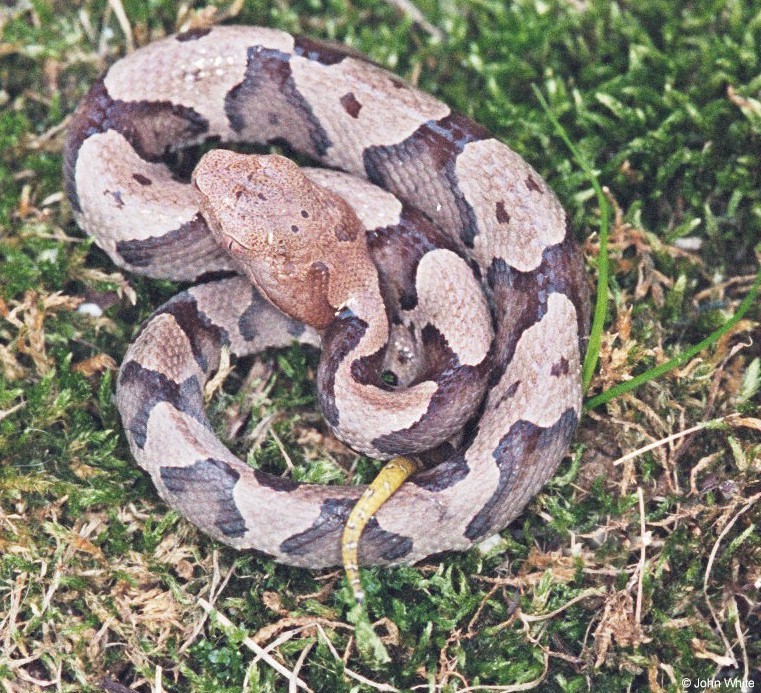
Eastern Copperheads have dark colored crossbands that are for the most part shaped like an hourglass. Usually some of the crossbands are broken and do not connect.
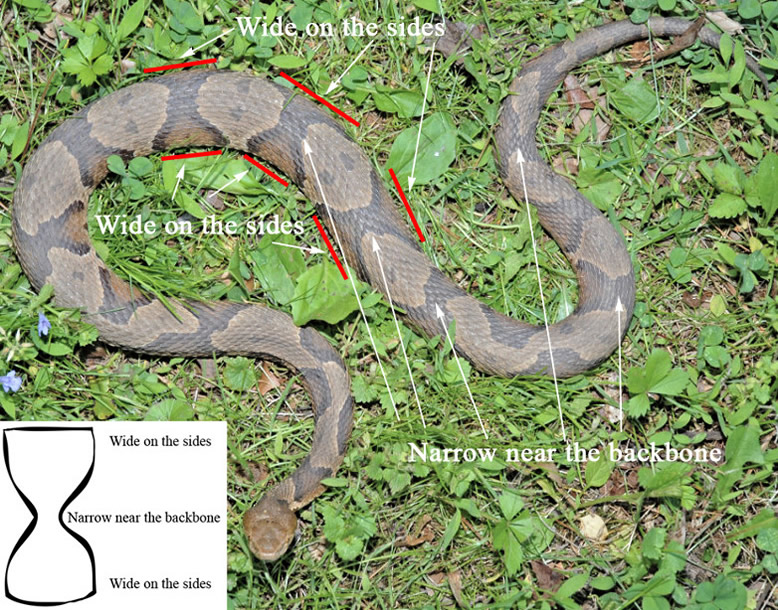
The Eastern Copperhead is a pit-viper, as are all three of Virginia's
venomous snake species (Eastern Copperhead, eastern cottonmouth and timber rattlesnake). The
"pit" in pit-viper refers to the heating sensing pit located between the eye and the
 nostrils on the snake's head. In addition to the heat sensing pit
all three venomous snakes in Virginia have vertical pupils. All harmless snakes in Virginia have
round pupils and lack the heat sensing pits.
nostrils on the snake's head. In addition to the heat sensing pit
all three venomous snakes in Virginia have vertical pupils. All harmless snakes in Virginia have
round pupils and lack the heat sensing pits. 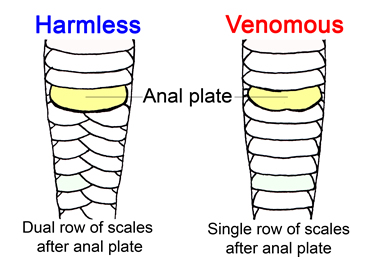 Another characteristic of all
Virginia's venomous snakes is the single row of scales on the underside of the tail after the
anal plate (vent).
Another characteristic of all
Virginia's venomous snakes is the single row of scales on the underside of the tail after the
anal plate (vent).
While close inspection of a snake's face and/or its bum is a definitive way to distinguish a venomous snake from a harmless species, it requires one to get dangerously close to a potently dangerous animal. It is far better to learn the pattern and coloration of a few snakes so that a specimen may be identified from a safe distance.
Copperheads play a pivotal role in controlling rodent populations. Without copperheads and other rodent eating snakes there would be a drastic increase in crop/food damage and rodent spread diseases. While Copperheads are venomous they are very placid snakes that only bite if stepped on or otherwise threatened. If you see a copperhead, leave it alone and rest assured it will do its best to avoid you.
Eastern Copperhead vs. Eastern Ratsnake
The most common snake misidentified as a copperhead is the harmless juvenile Eastern Ratsnake (formerly called the blackrat snake). The Eastern Ratsnake starts life with a strong pattern of gray or brown blotches on a pale gray background. As the Eastern Ratsnake ages the pattern fades and the snake becomes black, often with just a hint of the juvenile pattern remaining.
Around late August to mid-October depending on the temperatures, Eastern Ratsnakes look for a nice warm place to wait out the upcoming winter. Frequently these snake will choose a house attic, crawlspace or basement. Luckily, copperheads don't usually seek winter refuge in human occupied dwellings.
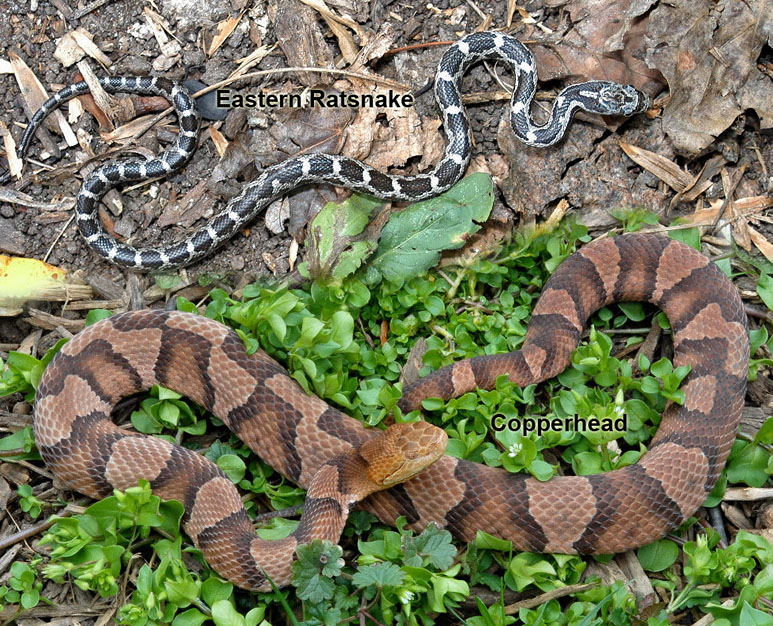
| Venomous Eastern Copperhead | Harmless Eastern Ratsnake |
 |
 |
| Both the Eastern Copperhead and Eastern Ratsnake are found state wide in Virginia. | |
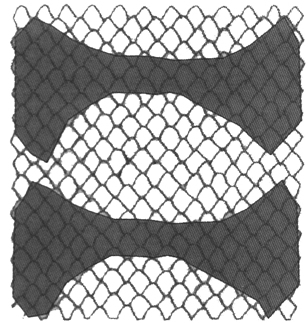 |
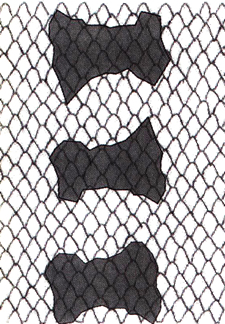 |
| The hourglass pattern on the copperhead's back starts on the side of the snake. | The blotch pattern of the Eastern Ratsnake do not extend to the sides. |
Eastern Copperhead vs. Northern Black Racer
Like the Eastern Ratsnake, black racers are also born with a blotched pattern. However, unlike the Eastern Ratsnake that may retain the juvenile pattern for several years, the pattern of the Northern Black Racer usually fades to a uniformed black within the first two years of life. Juvenile Northern Black Racers usually do not seek winter refuge in human occupied dwellings. Northern Black Racers are usually one of the first snakes to become active when spring arrives.
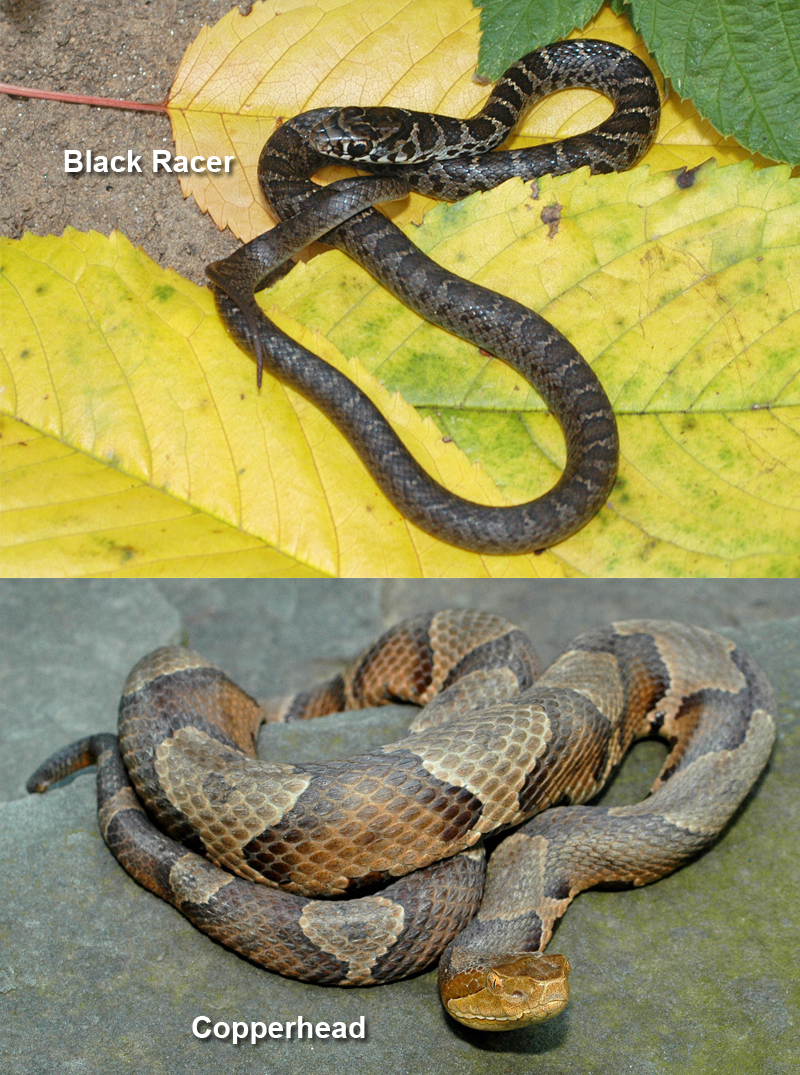
Venomous Eastern Copperhead |
Harmless Northern Black Racer |
 |
 |
| Both the Eastern Copperhead and Northern Black Racer are found state wide in Virginia. | |
 |
 |
Eastern Copperhead vs. Northern Watersnake
Juvenile and subadult Northern Watersnakes have a pattern that can vary greatly in color, from dark grayish to a reddish brown. The color of some individuals watersnakes can come close to that of some copperheads, however the pattern on the Northern Watersnake is always narrow on the sides and wide near the backbone. This is completely opposite of the pattern found on the copperhead (wide on the sides and narrow near the back bone). Some adult Northern Watersnakes retain a strong, distinct juvenile pattern while others become a uniformed brown. As the name implies, the Northern Watersnake is usually found in close proximity to water.

Venomous Eastern Copperhead |
Harmless Northern Water Snake |
 |
 |
| Both the Eastern Copperhead and Northern Watersnake are found state wide in Virginia. | |
 |
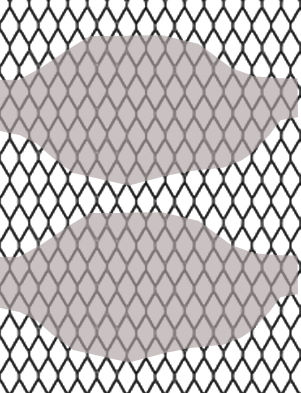 |
Eastern Copperhead vs. Eastern Milksnake
The pattern of the Eastern Milksnake is fairly consistent in Virginia, however the intensity of the colors can vary quite a bit. Usually the blotches across the back are outlined in black. Eastern Milksnakes are found state wide, but are more abundant in the mountainous regions.
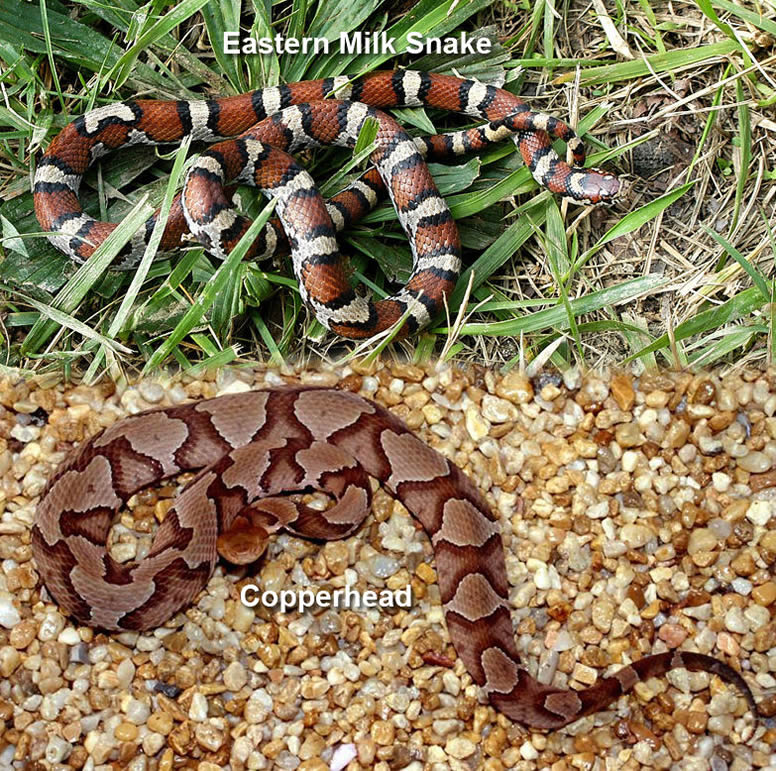
Venomous Eastern Copperhead |
Harmless Eastern Milksnake |
 |
 |
| Both the Eastern Copperhead and Eastern Milksnake are found state wide in Virginia. | |
 |
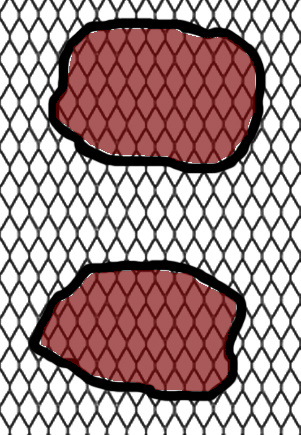 |
Eastern Copperhead vs. Eastern Hog-nosed Snake
Eastern Hog-nosed Snakes are the great actors of the snake world. In an effort to ward off predators these snakes will puff-up, hiss loudly, spread their neck and strike with the mouth closed. If all else fails the hognose snake will roll over and play dead. Found state wide the pattern and coloration of these snake can vary greatly. Eastern hognose snakes prefer sandy soil and primarily feed on toads.
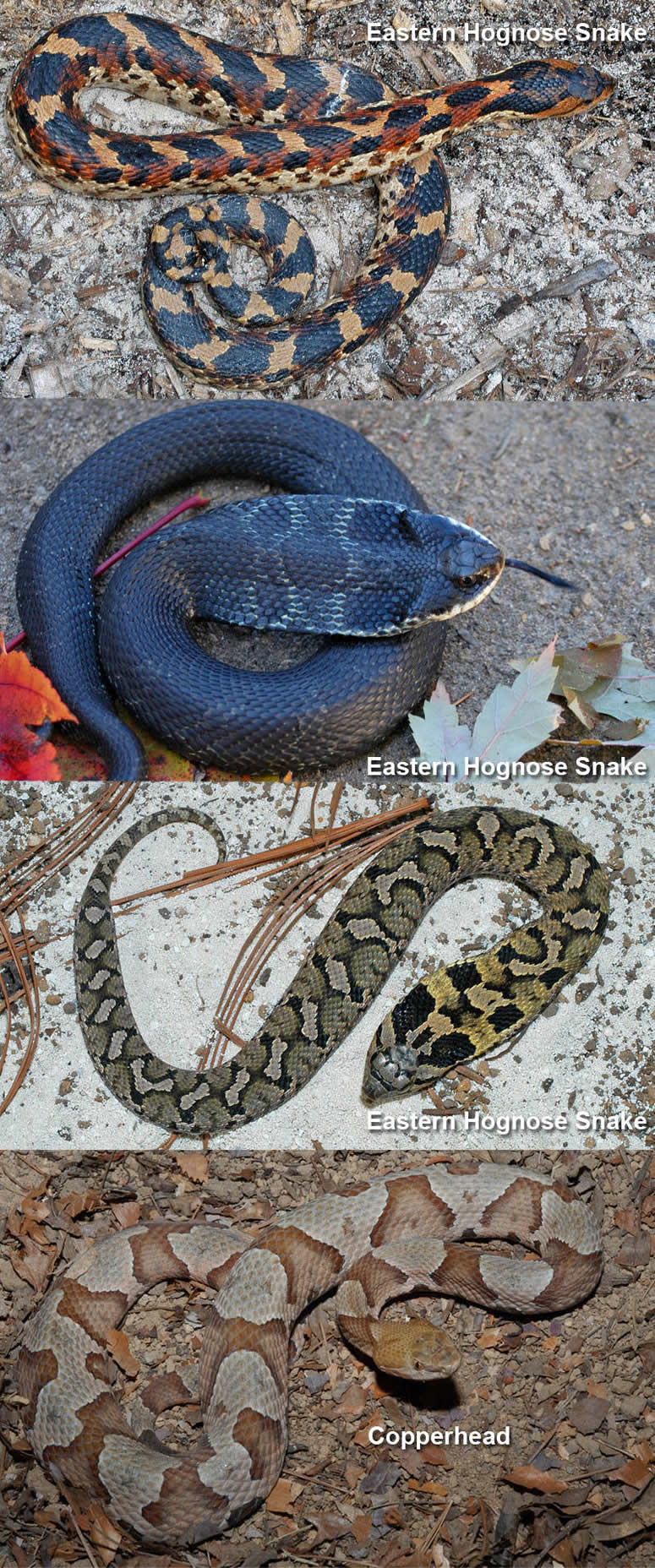
Venomous Eastern Copperhead |
Harmless Eastern Hog-nosed Snake |
 |
 |
| Both the Eastern Copperhead and Eastern Milksnake are found state wide in Virginia. | |
 |
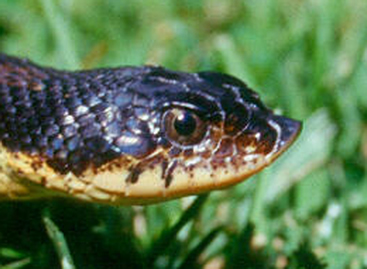 |
The pattern of the eastern hog-nosed snake can vary greatly
and thus isn't a reliable identifying characteristic. The upturned
snout of the hognose snake is unique among Virginia's snakes.
Eastern Copperhead vs. Red Cornsnake
The Red Cornsnake also known as the red ratsnake is usually more brightly colored and and has a more reddish hue than that of the copperhead. The pattern of the Red Cornsnake is a blotch that does not extend down the sides to the ground. Unlike the juvenile pattern of the Eastern Ratsnake that fades as the snake ages, the pattern of the Red Cornsnake remains distinct regardless of age.
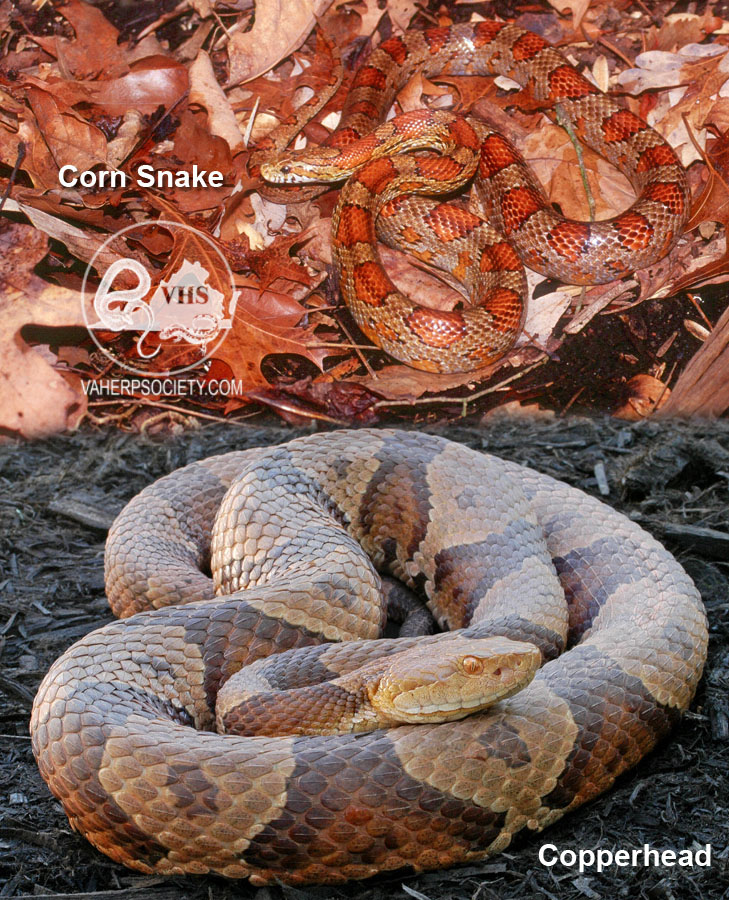
Venomous Eastern Copperhead |
Harmless Red Cornsnake |
 |
 |
 |
 |
Eastern Copperhead vs. Northern Mole Kingsnake
Juvenile Northern Mole Kingsnakes have a strong pattern that usually, but not always fades to a uniformed brown as the snake ages. Northern Mole Kingsnakes are seldom seen out in the open and are general found under surface cover (plywood, tin, flat rocks, etc..). Northern Mole Kingsnakes will sometime venture out in the open after a heavy rain.
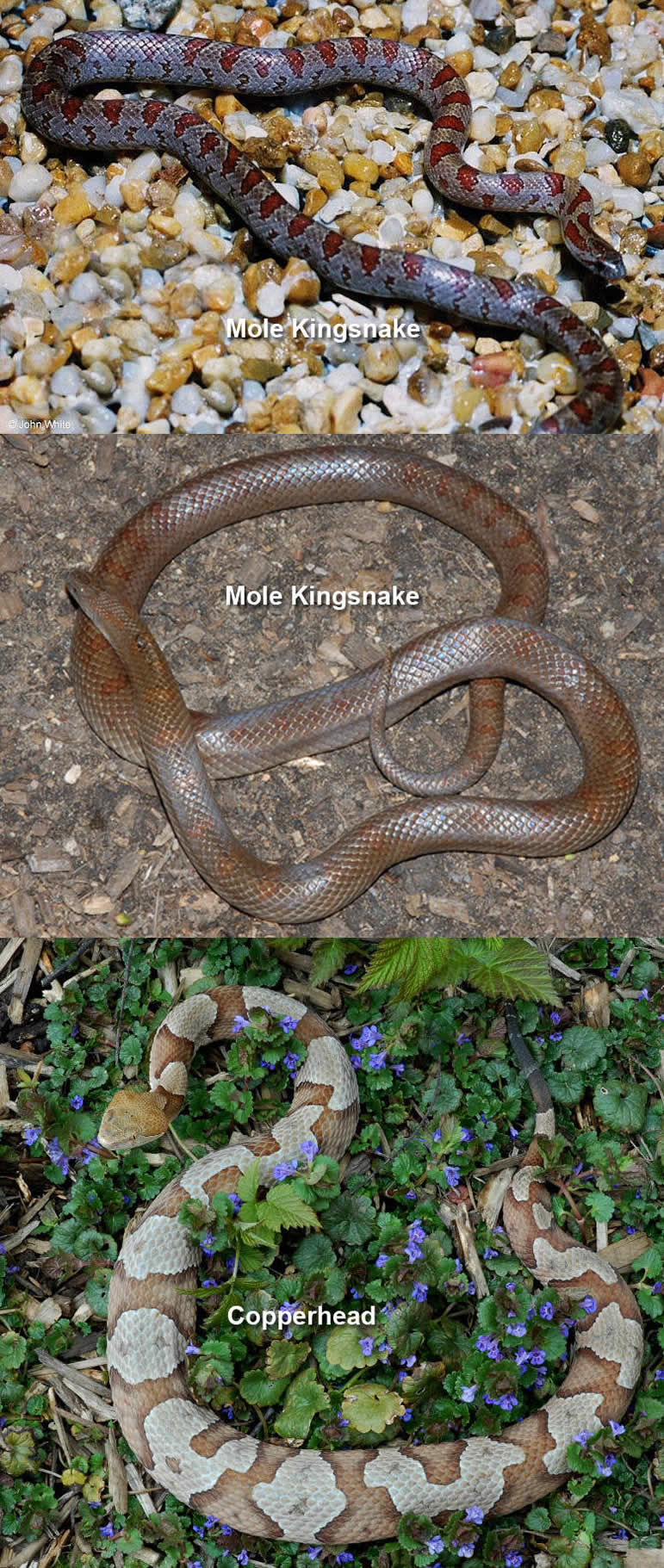
Venomous Eastern Copperhead |
Harmless Northern Mole Kingsnake |
 |
 |
 |
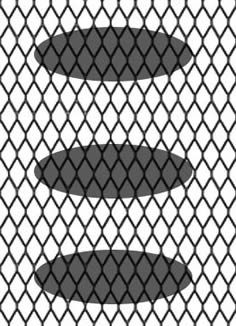 |


